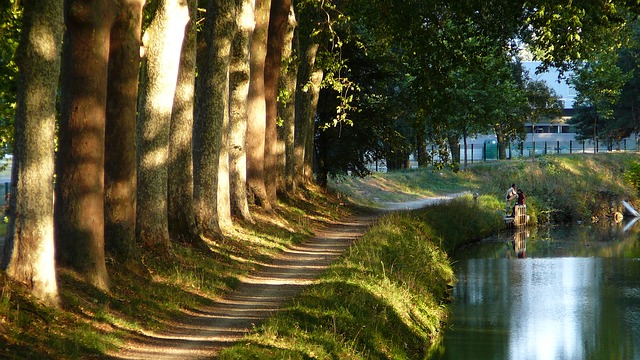Trail running for beginners
 I went through my website and saw that I have written many articles about trail running. I waxed poetically about my trails. I documented grueling trail races. I posted videos of Buddy and I out in the woods.
I went through my website and saw that I have written many articles about trail running. I waxed poetically about my trails. I documented grueling trail races. I posted videos of Buddy and I out in the woods.
I wrote about how to fall down. I told you how trails are rated for difficulty level. I wrote about the benefits and the risks of trail running. Those articles are all out there! It seems to me that I always start to write an article on trail running basics but then get sidetracked into something more fun!
Let’s step back and take it from the beginning.
If you have never run on a trail what can you expect?
- Trails are bit more difficult than running on the sidewalk. Depending on the rating of the trail they can be much, much more difficult. If you are planning to take your running off-road expect to work a little harder.
- This means your pace will be slower, sometimes significantly slower on the trails. That’s ok because you’re still getting a great workout. Road pace vs trail pace is just apples and oranges. Expect it so you don’t look at your times and get bummed out.
- You will have to adapt your form and turnover to the trails.
- The trail may have obstacles and/or surface variations that will necessitate you adapting you stride. You have to look ahead, see the obstacle coming and decide where to plant your feet to take advantage of the trail topology. You can’t drag your feet or you’ll trip on obstacles. Typically this means a shorter stride length with a faster cadence and keeping your feet off the ground. Again, nothing to worry about, just to be aware of.
- Expect to use some new muscles, tendons and other bits.
- Because of the mixed topology you tend to have a lot more lateral motion in the trails. This will work your ankles, hips, knees and core more than just running in a straight line. Just be aware that it takes time to get used to the sheer of the trails and you need to build up your body’s response to the challenge.
- Learn the flora and fauna constraints for your area.
- If you live in the southwest where all the plants bite you’ll want to avoid brushing against them. If you live up where I live you have to figure out how to keep the biting flies away. If you’re up in the Northwest you might need a Grizzly strategy! It’s nothing to be frightened of, just make sure you’re aware of how to coexist with your local flora and fauna.
- Be willing to get a little scraped up.
- There have been many times in the last 20 years where I’ve, caught a toe, taken a tumble and ended up face down in the trail with the dog laughing at me. It’s no big deal. You get a little scraped up and a bit dirty. That’s part of the fun! Expect it. Get up. Dust off and keep going.
- Don’t get lost.
- These days you can actually use your GPS phone to find out where you are even on most trails. Unlike the roads the trails may not have signs. You have to be aware of where you are and how you’re going to get back. Again, nothing to be worried about, just something to think about as you’re getting ready.
What does this mean for you beginners? It’s great news! You are in for an adventure if you’ve never run a trail.
How do you do it and have an enjoyable experience?
First, do a bit of research in your area. Where are the trails? What difficulty level are they rate? Are there maps available? What are the local flora and fauna that you need to be aware of and perhaps, prepare for?
How do you find this information? You can Google it. Typically there are local organizations that manage the trails that you can get maps and info from. Many of the trail systems are actually in the various electronic maps now and may even be in your favorite running app.
The best way may still be to find a local trail runner. Get some old-timer like me who knows all the trails within a 50 mile radius to give you some suggestions based on your experience level. Maybe even get a guided tour. Just be careful said trail-runner-guide isn’t a crazy person who is going to get you in over your head. Which leads us to our next point.
Ease into it. Start the first couple weeks doing less mileage than you would normally. Go purposely slower. Run purposefully with a heightened awareness of your form. Allow your body time to adapt to the trails. Don’t start with the most difficult trail.
Another question you might have is “Do I need any special equipment to run trails?”
No, you really don’t. Depending on where you live you might need some bug spray or a good hat. If you’re going long, just like on the road you need fluid and fuel and that can be more challenging to provision in the trails.
Eventually, if you decide you like trail running, you might get some trail shoes or other trail specific clothing and accessories. Like gators, water packs, water bottles, etc. But if you’re just starting you don’t need any of that. Your road shoes will be fine.
In summary, trail running is simple. Do some research on your trails. Ease into it. Have fun. If you like it, take it to the next level and sign up for a trail race. The trail racing community is a bunch of laid back hippy types who are fun to hang with.
I love trail running. The gnarlier the better. I find a certain spiritual refreshment out in the woods. Even when it’s hot, slow and buggy.
Do yourself a favor and go find a trail.


Hey there Chris,
Love your podcast– I recently discovered it and just listened to this one about trail running on my ride home from work. I love trail running, all things running, and I’m so glad I found your work! Keep doing what you’re doing! Love it! SDC
Thanks Bud, got more trails coming.